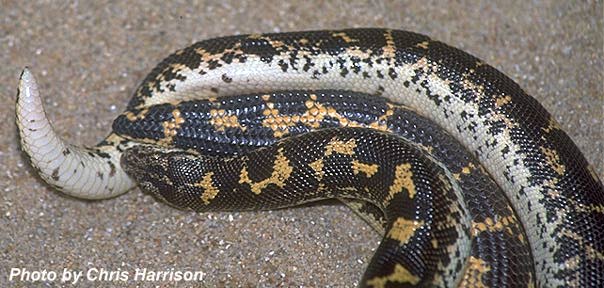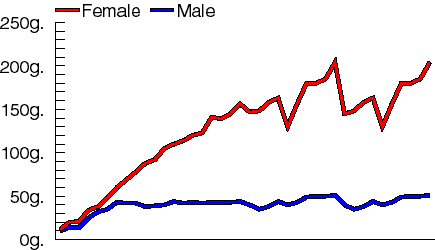 | mobile - desktop |
 | mobile - desktop |
 |
Contact Sales! |
News & Events:
|


Captive ReproductionThere are only three species of Sand Boa that are regularly bred in the United States. Those are the East African Sand Boa (E. colubrinus), the Rough-scaled Sand Boa (E. conicus) and the Indian Sand Boa (E. johnii). Other species, such as the Spotted Sand Boa (E. jaculus), the Desert Sand Boa (E. miliaris) and the Tartar Sand Boa (E. tataricus) are less frequently bred. The other species of Sand Boa have never, or only rarely, been bred in captivity. Sexing Sand BoasOne of the first things necessary for captive breeding is an adult pair of Sand Boas. Sand Boas are relatively easy to sex as adults by the relative tail lengths and their adult size. For most species, females are much larger than males and have relatively shorter tails (see the above photo and this link to Denise Loving's page on sexing baby sand boas). Males of some species have more prominent spurs, but size and tail length are more reliable indicators in adult snakes. Adult SizeUnder captive conditions, Sand Boas can reach breeding size in 3-4 years. There are some instances where snake breeders have "pushed" their snakes and forced them to reach breeding size at less than 2 years. However, there is a well documented life history trade-off between age at maturity and life expectency in animals and because of this, pushing animals into accelerated growth and early reproduction may shorten life expectency and result in stunted adult size. In general, snakes are ready to breed at around two-thirds to three-quarters of the average adult size. For female Sand Boas, the critical factor is the weight of the female rather than the length. Females of most species grow rapidly in length for the first couple of years and then begin to put on weight as they approach maturity. Therefore a two year old 17 inch Desert Sand Boa that weighs 100 grams is not sexually mature but a year later when she is 18 inches long and weighs 160 grams she may be. The large sexual dimorphism in size of sand boas shows up early in life. The typical growth pattern is for both male and females to progress to just below adult male size and then for the females to keep growing as the male's growth rate plateaus off. 
This figure shows this pattern of growth in the monthly weights of a captive born pair of Eryx miliaris. The prominent drops in the female's weight represent months where she had just given birth. Here are some approximate guidelines for some species: (if you have any data to add please email me)
Stimulating ReproductionBecause of the broad distribution of Sand Boas, the environmental factors which trigger reproduction differ from species to species. Some of the more tropical species (E. colubrinus, E. conicus) may reproduce without any period of brumation (inactivity during cool weather - often incorrectly called hibernation by hobbyists) while the more temperate species, such as E. tataricus, will not reproduce unless cooled off for several weeks or months. Some breeders cool of some species and not others, while other breeders successfully produce young without any cooling off period. The best general rule is to try and copy the climate of the area the snakes originate from. I have had success by cooling off the males of some species while keeping the females at normal captive temperatures in order to feed them to prepare them for the rigors of breeding. For some species, increases in relative humidity have been shown to stimulate reproductive activity, while other species seem to be ready to mate at any time (this does not mean they can produce young, just that the males will court the females at any time.) Sand Boas are live bearers. The female retains the embryos in her body and gives "birth" to them as fully developed little Sand Boas encased in little membranes. Many sources I have seen give a wide range of gestation periods for Sand Boas, ranging from 2 months to 8 months or more. Obviously, temperature will affect the length of the gestation, but not to the degree observed in the above range. I believe a lot of this confusion stems from observing courtship weeks or months prior to the actual successful mating (resulting in longer perceived gestation) or from observing courtship behavior after the female is already gravid (resulting in shorter perceived gestation). In general, gestation for Sand Boas lasts around 4 months. Frequently, no mating is observed (although I have seen my Sand Boas courting many times, I have never actually witnessed mating) and the date of fertilization is unknown. To determine when to put your snakes together, I suggest you look at the distribution of captive births for the species you are interested in and subtract four months. I usually put my snakes together several days a week for a few weeks before the expected period and continue doing this for a month or so. I have had good success doing this and have produced offspring around the expected time by this technique. Males will frequently stop feeding around this time and may be unusually active. The Gravid Female - So if you don't observe mating, or even if you do, how do you know if your snake is gravid? (I have had a couple of Sand Boas that I believed were gravid never give birth and have had a few surprise clutches from snakes that I had no idea were gravid. It is difficult to tell with heavy bodied snakes like Sand Boas). I think the most useful indicator of a female being gravid is her behavior. Gravid females will usually spend a lot of time laying in the warmest part of the cage, often right on the heat tape. They will often refuse food or only accept small food items or even regurgitate food items that are too large (avoid this; only offer small meals). Some of my females become a little more likely to bite if disturbed late in the gestation. Often the female will become very distended along the last half of her body and this is the part of the body she will often place on the heat tape. A carefully monitored under cage heat source is crucial to proper gestation! Females will sit on a heat source that is too hot if no appropriate source is available. I make sure the surface temperature at the hot spot is between 90° and 95° F. Birth - Toward the later stages of gestation, I have noticed that the mass of the clutch seems to move down closer to the tail of the female. Unlike in egg laying snakes, there is no predictable pre-birth shed. Usually I notice that the female is particularly active at dusk for a few days. At this time I place a container of moist sphagnum moss in the cage. Sometimes the female will give birth in it and it helps the babies get free of their embryonic membranes. I avoid keeping females on sand or other fine substrate as the newborn snakes can have trouble freeing themselves from their sand-caked membranes and even when they do, the sand often gets caked on their eyes and around their mouths. The birth invariably takes place at night (usually when you're out of town for some reason). Care of newborns - I move the newborn Sand Boas to a clean shoebox with moist paper towels for a few hours to allow them to get the last of the birth membrane and any other substrate off them. Then I place them in a clean shoebox with paper towels and a hide box and a shallow water bowl. They will shed within a week or ten days and then I offer them food (see the feeding page for more information on feeding baby Sand Boas). Back to the Sand Boa Care Page
|
Sponsored Link
New & Updated Business Listings |